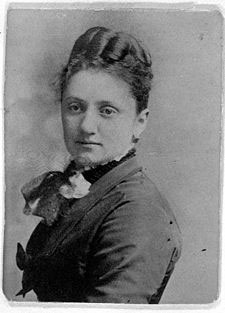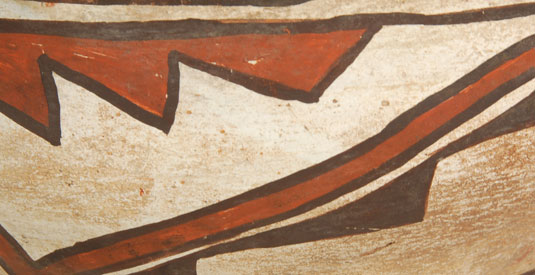Zuni Pueblo Polychrome Historic Dough Bowl [SOLD]
+ Add to my watchlist Forward to Friend
- Category: Historic
- Origin: Zuni Pueblo, SHE-WE-NA
- Medium: clay, pigment
- Size: 5-1/2” deep x 11-3/8” diameter
- Item # C3783C SOLD
It would be interesting to share with you a little about the history involving Zuni Pueblo before giving details about this dough bowl - used when making bread. The Bureau of Ethnology (BAE) was created by an act of Congress in 1879 and put under the control of the Smithsonian Institution, with John Wesley Powell as its first director. He wasted no time in setting up his plans for the BAE. Within a few months, he sent an expedition to visit Zuni Pueblo to collect material from and information about the Zuni culture.
 Colonel James Stevenson and his wife, Matilda Coxe Stevenson, departed for Zuni on August 1, 1879 also to collect for the BAE. John K. Hillers, photographer, and Frank Hamilton Cushing, ethnology assistant at the Smithsonian, accompanied the Stevensons.
Colonel James Stevenson and his wife, Matilda Coxe Stevenson, departed for Zuni on August 1, 1879 also to collect for the BAE. John K. Hillers, photographer, and Frank Hamilton Cushing, ethnology assistant at the Smithsonian, accompanied the Stevensons.
On their first expedition, the Stevensons collected over 4000 items and sent them back to the Smithsonian. They returned to Zuni on a second expedition in 1881 and collected another 3700 items. Their third trip to Zuni, in 1884-1885, resulted in more items. Overall, the pottery items from the three expeditions totaled over 5000. Between 1879 and 1916, it is estimated that over 13,500 items were collected from Zuni Pueblo and sent to the Smithsonian.
It is a wonder that there was any pottery remaining at Zuni after these expeditions. The potters, of course, had to continue making more for their own use and for sale to traders and tourists. This bowl is probably one made for use as there is some abrasion to the design on the interior. It certainly was not used extensively as there is very little noticeable wear pattern. The owner was probably pressed to sell it so she let it go and made another for her own use.
Before 1850, all Zuni bowls and jars had red bottoms. Around 1850, the use of red pigment for the underbodies began to decline and by 1895, it was completely replaced with brown paint. At some time between 1850 and 1895, some potters placed red pigment on the underbodies then overpainted the red with brown. This bowl appears to be one in which that was done. Close examination reveals areas of red under the brown. This discovery would lead one to put a date of 1880s on this dough bowl.
The bowl perhaps was made by an older potter because it tilts slightly, being 5-1/2” deep if measured on one side and 5” deep if measured on the opposite side. The painted design is somewhat loose in structure with wavy lines rather than straight ones. When examined with UV light, the dark brown paint on the exterior of the bowl has a green luminous essence. This is something with which I am not familiar. Over-paint displays as black under UV light. This green luminous glow is not over-paint but probably some mineral inherent in the brown pigment.
Condition: there does not appear to be any repairs or restoration or overpaint on this Zuni Pueblo Polychrome Historic Dough Bowl.
Recommended Reading: The Pottery of Zuni Pueblo by Harlow and Lanmon
Provenance: from the collection of a family from Santa Fe

- Category: Historic
- Origin: Zuni Pueblo, SHE-WE-NA
- Medium: clay, pigment
- Size: 5-1/2” deep x 11-3/8” diameter
- Item # C3783C SOLD



